Have you heard the children's song about the cat who always came back to poor Mr. Johnson, who lived all alone? He blows the cat up, he drowns it, he runs it over, but no matter how hard he tries to get rid of this cat, it always comes back. "It just wouldn't stay away -ay -ay -ay." Well, that's how I feel about my Coreopsis!
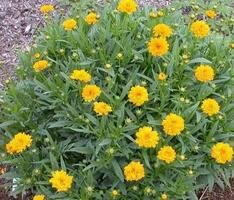 (Editor's Note: This article was originally published on March 3, 2008. Your comments are welcome, but please be aware that authors of previously published articles may not be able to promptly respond to new questions or comments.)
(Editor's Note: This article was originally published on March 3, 2008. Your comments are welcome, but please be aware that authors of previously published articles may not be able to promptly respond to new questions or comments.)
The first real perennial I ever planted was
Coreopsis 'Early Sunrise'. I don't remember anything about the soil, or the drainage, or the moisture, or the amount of sun or shade it got. I just dug a hole and stuck it in. I do remember that it came back every summer and bloomed and bloomed and bloomed. I discovered (all by myself, I might add) that if I picked off the dead flowers, new ones would replace them. It didn't occur to me that I should be fertilizing it, using water-holding crystals or giving it foliar feedings with alfalfa tea because I hadn't heard of most of those things. It was planted against a chain-link fence, and grew tall and strong against the fence. I don't have any pictures of it because I was too busy taking pictures of the children I was growing to waste film (yes, film) on anything so silly as a plant! I haven't lived at that house since my 14-year-old daughter was born.
In my new house, where I planned to stay longer, I planted things in containers while deciding what to do about seemingly more pressing concerns (the water in the basement, the absence of a refrigerator in the kitchen). The previous owner had left behind half a whiskey barrel, and I found a plant that I liked at a garden center to put in it. It was the same Coreopsis thing, only this one was
Coreopsis 'Moonbeam'. It looked ok to me, why not? I stuck it in the whiskey barrel and continued the business of being a mother and wife in a wheelchair.
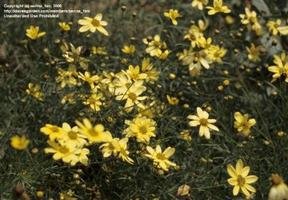
Three or four years later, with my older daughter in kindergarten and my younger daughter in preschool, I had five to ten minutes of free time at a stretch. I had been learning a lot. I had a retaining wall built, and filled it with things like "topsoil", "compost" and "loam". I planted some herbs and some flowers. I noticed that my lovely coreopsis, which had been blooming reliably every year with no attention from me, was starting to show signs of age. The whiskey barrel didn't look so hot any more either.
I learned that perennials, like my coreopsis, needed "dividing" which made them "multiply". My plant, in its whiskey barrel, seemed dead in the middle while lively around the fringes. Hmmm. Was it time to deliver twins? I purchased two splendid, matching granite-colored plastic containers. These would house my new babies. A self-styled expert friend of mine helped me perform the surgery. Using scalpels, retractors, intravenous transfusions and hemostats, we cut away the dead parts and ended up with two live, healthy, green specimens of
Coreopsis 'Moonbeam', which we carefully planted in their new plastic pots. There was one tiny sliver left over. Reluctant to discard anything alive and growing and with its own name, I tucked it in the back of my new raised bed, the one with the loam, compost and topsoil. That simple act of kindness nearly proved to be my undoing.
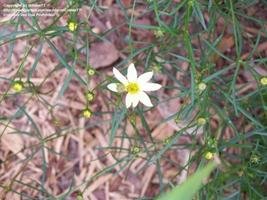
If you've ever had a mint or a plant that's just TOO hardy in your garden, you can guess the rest of the story. The next spring, I had mush left in my beautiful, granite-colored, plastic containers. But my orderly retaining
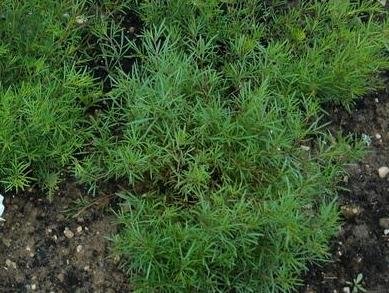
wall garden had those tell-tale bright green feathery Coreopsis fringes all along the back. Behind the bee balm (
Monarda). Behind the new purple coneflower (
Echinacea purpurea). (In case you don't know, this particular Coreopsis is low-growing, 18 to 24 inches tall, and it is often suggested for the middle or front of a border - not the back!) I think late that summer I joined Dave's Garden. Then I REALLY started to learn.
One of the very first things I learned was how (and how not) to package a clump or division for shipment. I was trading away this
Coreopsis 'Moonbeam' as fast as I could. In return I got houseplants, outdooor plants, and cuttings I didn't really know how to handle, but I was getting rid of the
Coreopsis 'Moonbeam'. By the end of that summer I had gotten rid of almost all of it - except I hadn't yet heard that the first year (the year I planted the sliver) they sleep, the next year they creep, the third they leap. I was due for a LEAP year.
Sure enough, the NEXT spring saw those adorable feathery green fringes interspersed throughout

my retaining wall
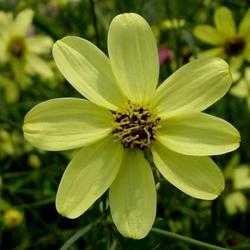
garden where once had been Tarragon (
Artemisia) and Oregano (
Origanum). The post office saw a great deal of me that summer, as I sent away clump after clump of Coreopsis. As fast as I sent it away, it seemed to be devouring the compost, topsoil, and loam of my garden. It sprang up again double everywhere I cut it out. That summer - which was last summer - I chopped out great hunks of root systems and sent those away too. I may just have been sending away plant material for other peoples compost piles; I wouldn't

put that creature in my own compost pile.
Last year was my first year successfully growing plants from seeds - on purpose. (We all do it all the time without wanting to with dandelions and so forth.) Last fall, as I surveyed the wall garden with grim satisfaction, I didn't see any traces of
Coreopsis 'Moonbeam'. Left in its wake was a moonscape of potholes and gaps. There are a few filled in with potting soil and an annual - dead, now, of course - just to prevent a vaccuum. There are some new perennials (shorter ones in the front and longer ones in the back, this time), and a plan to replenish the soil with more loam and compost, this time home-made. I continued my gaze out across where once was ordinary high-maintenance grass and now resided Columbine (
Aquilegia), Yarrow (
Achillea) and Salvia (
Salvia). To my horror, way in the back by the daylilies, I spotted a bright green feathery spray of Coreopsis. Did it self-seed? Did that massive you-will-be-assimilated root system crawl all the way over there? Now that I, too, espouse the widely-held belief that plants
do come from seeds, I think I favor the former theory.
So this spring, as I nurture my homegrown seedlings of well-behaved, dwarf perennials, I realize that if Nature really wants
Coreopsis 'Moonbeam' to have a presence in my yard, this is the perfect spot. It's the closest, in an urban setting, that I can come to a wildflower meadow. It's the least-orderly of my garden corners, the least controlled and organized, the wildest. In fact, it's the place that's been crying out for some Moonbeams all along!






 (Editor's Note: This article was originally published on March 3, 2008. Your comments are welcome, but please be aware that authors of previously published articles may not be able to promptly respond to new questions or comments.)
The first real perennial I ever planted was Coreopsis 'Early Sunrise'. I don't remember anything about the soil, or the drainage, or the moisture, or the amount of sun or shade it got. I just dug a hole and stuck it in. I do remember that it came back every summer and bloomed and bloomed and bloomed. I discovered (all by myself, I might add) that if I picked off the dead flowers, new ones would replace them. It didn't occur to me that I should be fertilizing it, using water-holding crystals or giving it foliar feedings with alfalfa tea because I hadn't heard of most of those things. It was planted against a chain-link fence, and grew tall and strong against the fence. I don't have any pictures of it because I was too busy taking pictures of the children I was growing to waste film (yes, film) on anything so silly as a plant! I haven't lived at that house since my 14-year-old daughter was born.
(Editor's Note: This article was originally published on March 3, 2008. Your comments are welcome, but please be aware that authors of previously published articles may not be able to promptly respond to new questions or comments.)
The first real perennial I ever planted was Coreopsis 'Early Sunrise'. I don't remember anything about the soil, or the drainage, or the moisture, or the amount of sun or shade it got. I just dug a hole and stuck it in. I do remember that it came back every summer and bloomed and bloomed and bloomed. I discovered (all by myself, I might add) that if I picked off the dead flowers, new ones would replace them. It didn't occur to me that I should be fertilizing it, using water-holding crystals or giving it foliar feedings with alfalfa tea because I hadn't heard of most of those things. It was planted against a chain-link fence, and grew tall and strong against the fence. I don't have any pictures of it because I was too busy taking pictures of the children I was growing to waste film (yes, film) on anything so silly as a plant! I haven't lived at that house since my 14-year-old daughter was born.

 wall garden had those tell-tale bright green feathery Coreopsis fringes all along the back. Behind the bee balm (Monarda). Behind the new purple coneflower (Echinacea purpurea). (In case you don't know, this particular Coreopsis is low-growing, 18 to 24 inches tall, and it is often suggested for the middle or front of a border - not the back!) I think late that summer I joined Dave's Garden. Then I REALLY started to learn.
wall garden had those tell-tale bright green feathery Coreopsis fringes all along the back. Behind the bee balm (Monarda). Behind the new purple coneflower (Echinacea purpurea). (In case you don't know, this particular Coreopsis is low-growing, 18 to 24 inches tall, and it is often suggested for the middle or front of a border - not the back!) I think late that summer I joined Dave's Garden. Then I REALLY started to learn.
 my retaining wall
my retaining wall  garden where once had been Tarragon (Artemisia) and Oregano (Origanum). The post office saw a great deal of me that summer, as I sent away clump after clump of Coreopsis. As fast as I sent it away, it seemed to be devouring the compost, topsoil, and loam of my garden. It sprang up again double everywhere I cut it out. That summer - which was last summer - I chopped out great hunks of root systems and sent those away too. I may just have been sending away plant material for other peoples compost piles; I wouldn't
garden where once had been Tarragon (Artemisia) and Oregano (Origanum). The post office saw a great deal of me that summer, as I sent away clump after clump of Coreopsis. As fast as I sent it away, it seemed to be devouring the compost, topsoil, and loam of my garden. It sprang up again double everywhere I cut it out. That summer - which was last summer - I chopped out great hunks of root systems and sent those away too. I may just have been sending away plant material for other peoples compost piles; I wouldn't put that creature in my own compost pile.
put that creature in my own compost pile.